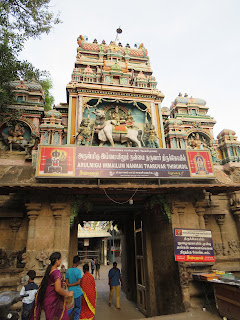Immaiyilum Nanmai Tharuvaar Temple - Madurai
There are two unique things about this temple. We could see only the back side of Shiv Linga as he faces the opposite direction of the sanctum's entrance. Lord Shiva himself installed and worshiped this Shiv Linga, which is very unique.
Legend
As per the legends related to Madurai, Meenakshi, the incarnation of Uma, was born as a Pandya princess, and she ruled the empire. She invaded many kingdoms in Bharat and went up to the Himalayas. There, she met Lord Shiva on a battlefield, which resulted in her marriage to him. Lord Shiva settled down in Madurai. He ruled the empire in the name of Sundaresha (Sundara Pandya). Before his coronation, he installed, worshiped, and performed poojas to the Shiv Linga of this temple. (As per the tradition of all the Pandya kings, they had to worship Shiv Linga before their coronation). As Shiva installed his own icon, this site is called Atma Linga Kshetram.
History
The temple was built by Sundara Pandya in 1218 CE. A King, Kalathiyappa by name, renovated this temple (in the middle of the 16th century CE?). These details are found in the book "Tiruvaalavudaiyar Tiruppani Malai". To my knowledge, there is no inscription found. The temple is completely renovated. Except for the presiding deity, Goddess, and very few bronze icons, everything else appears to belong to a later period.
Temple Layout
Temple Entrance
The west-facing temple has a small tower at the entrance. There is another entrance in the east direction which has no tower.
Immaiyilum Nanmai Tharuvaar
Ardha Mandapa
Kodanda Rama
Stone Image of Nataraja
Other Deities
The icons of Saraswati, Surya, Lakshmi, and Chandra are found in the opposite direction. Jwara Linga and Jwara Shakti are also found in the inner prakara. All the bronze icons are placed in a separate sub-shrine.
Dakshinamurti, Lingodbhava, Brahma, Durga, and another Goddess (name unknown) are found as the Koshta deities. Chandikeshwara is found in his usual location. In addition, the Avatar of Shiva, Ellam Valla Siddha is also located near the niche image of Durga.
Nandi Mandapa, flagstaff, and bali peetha face the main shrine's direction in the open corridor. The sub-shrines of Navagraha and Bhairava are found in the outer prakara. Veerabhadra is also found in the sub-shrine of Bhairava. Bilva, the sthala vruksha (sacred tree) is located near this shrine. The temple tank is located on the north side of the temple. The sub-shrines of Ganesha and Kartikeya are found near the main entrance, facing east.
Madhyapuri
The Goddess of the temple is Madhyapuri Amman. (It should be noted that this area was initially called Naduvur, meaning the town in the middle. The Goddess is Madhyapuri, which means the Goddess of the city/region in the middle). She is found in a separate south-facing shrine. The shrine is more like a separate temple with its own mandapa, prakara, flagstaff, bali peetha, and Nandi. The attractive idol of Madhaypuri is found in the standing posture. Sri Chakra, made of stone, is located in the sanctum, which is very rare. Generally, Sri Chakra is made of copper in all other temples.
Ganesha and Subramanya are found on either side of her Ardha Mandapa entrance. Ichcha Shakti, Kriya Shakti, Gnana Shakti, Saraswati, and Brahma are niche deities. Chandikeshwari, the female form of Chandikeshwara, is found in the inner prakara. The sub-shrines of Ganesha and Subramanya-Valli-Devasana are located in the same prakara. Lingodbhava is found under the sacred peepul tree, which is located on the backside of the Amman shrine.
Happy travelling.







.JPG)
Comments
Post a Comment